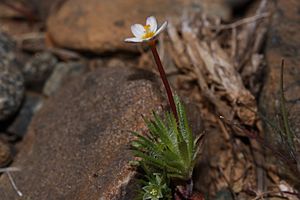Leptosiphon bicolor facts for kids
Quick facts for kids Leptosiphon bicolor |
|
|---|---|
 |
|
| Scientific classification | |
| Genus: |
Leptosiphon
|
| Species: |
bicolor
|
| Synonyms | |
|
Linanthus bicolor (Nutt.) Greene |
|
Leptosiphon bicolor, also known as true babystars, is a small, beautiful flowering plant. It's called "babystars" because its flowers are tiny and often look like little stars! This plant is an annual, which means it grows from a seed, flowers, produces new seeds, and then dies all within one year.
True babystars have thin, needle-like leaves that grow in small bunches. You can often find these plants with both white and pink flowers growing together in the same area.
Contents
Where Do True Babystars Grow?
True babystars are native to the west coast of North America. This means they naturally grow there and aren't brought in from other places. You can find them from the northern part of Baja California (in Mexico) all the way up to southern British Columbia (in Canada). They thrive in many different natural areas, like chaparral, woodlands, and open fields.
What Do True Babystars Look Like?
These plants are usually quite low to the ground. Their stems are thin, and their leaves are very narrow, almost like tiny needles. The flowers are small, but they can be very pretty, often appearing in clusters.
- Flowers: The flowers are usually white or pink. Sometimes, you might see a mix of both colors in a single group of plants.
- Leaves: The leaves are thin and pointed, like tiny needles. They grow in small clumps along the stem.
- Size: True babystars are small plants, usually only a few inches tall.
Life Cycle of True Babystars
As an annual plant, the true babystar goes through its entire life cycle in one year.
- Spring: Seeds sprout, and the plants begin to grow.
- Late Spring/Early Summer: The plants produce their beautiful white or pink flowers. These flowers attract pollinators like bees and other insects.
- Summer: After flowering, the plants produce seeds. These seeds will fall to the ground.
- Fall/Winter: The parent plant dies, but the seeds wait in the soil for the next spring to start the cycle all over again.
Why Are True Babystars Important?
Even though they are small, true babystars play a role in their environment.
- Pollinators: Their flowers provide nectar and pollen for insects, which helps these insects survive.
- Biodiversity: They add to the variety of plant life in their native habitats, which is important for a healthy ecosystem.
See also
 In Spanish: Leptosiphon bicolor para niños
In Spanish: Leptosiphon bicolor para niños

